
Artocarpus odoratissimus is a species of flowering plant in the Moraceae family. It is a commonly called marang, madang, timadang, terap, tarap, kiran, green pedalai, or johey oak. It is native to Borneo, Palawan, and Mindanao Island, and is closely related to the jackfruit, cempedak, and breadfruit trees which all belong to the same genus, Artocarpus.

Nepenthes sibuyanensis is a tropical pitcher plant endemic to Sibuyan Island in the Philippines, after which it is named.
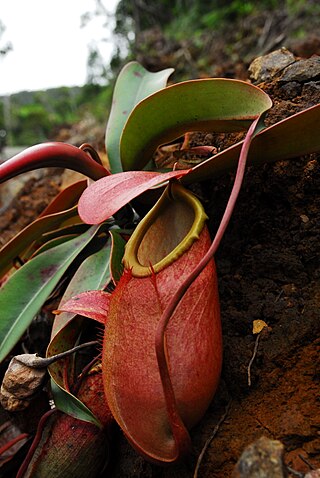
Nepenthes merrilliana is a tropical pitcher plant endemic to the Philippines. It produces some of the largest pitchers in the genus, rivalling those of N. rajah.
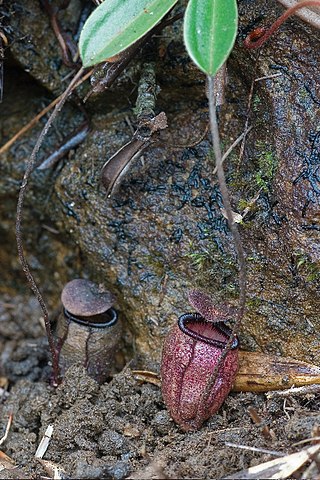
Nepenthes argentii is a highland Nepenthes pitcher plant native to Mount Guiting-Guiting on Sibuyan Island in the Philippines. It is possibly the smallest species in the genus and does not appear to have a climbing stage.

Nepenthes petiolata is a highland Nepenthes pitcher plant species endemic to Mindanao island in the Philippines, where it grows at an elevation of 1,450–1,900 metres (4,800–6,200 ft) above sea level.
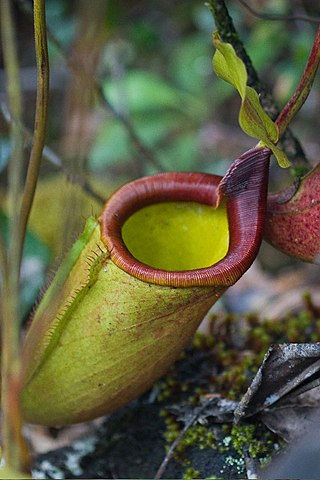
Nepenthes deaniana is a tropical pitcher plant endemic to the Philippines, where it grows at an altitude of 1180–1296 m above sea level. The species is known only from the summit region of Thumb Peak, a relatively small, ultramafic mountain in Puerto Princesa Province, Palawan.
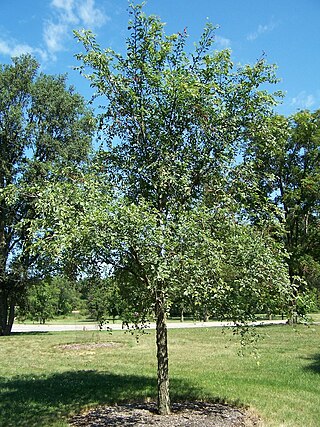
Ulmus chenmouiW. C. Cheng, commonly known as the Chenmou, or Langya Mountain elm, is a small deciduous tree from the more temperate provinces of Anhui and Jiangsu in eastern China, where it is found at elevations below 200 m on the Langya Shan and Baohua Shan mountains. The tree was unknown in the West until 1979, when seeds were sent from Beijing to the De Dorschkamp research institute at Wageningen in the Netherlands.
Elaeocarpus gigantifolius is a species of flowering plant in the Elaeocarpaceae family. It is found only in the Philippines.

Pelagodoxa is a genus of palm tree, it features 2 species, P. henryana & P. mesocarpa .They are found only in the Marquesas Islands of French Polynesia, & Vanuatu where they are both threatened by habitat loss.
Artocarpus blancoi is a species of plant in the family Moraceae endemic to the Philippines. Its habitat is threatened.

Artocarpus hypargyreus is a species of plant in the family Moraceae. It is endemic to China. It is threatened by habitat loss.
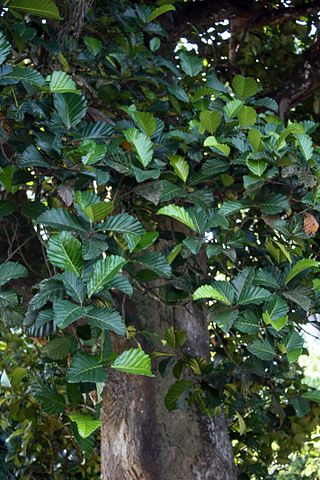
Artocarpus nobilis, the Ceylon breadfruit, is a tree species in the family Moraceae. It is endemic to south western regions of Sri Lanka. It is known as "Wal dhel - වල් දෙල්", "Baedi dhel - බැදි දෙල්" or as "Hingala dhel - හිංගල දෙල්" by local people.
Artocarpus rubrovenia is a species of plant in the family Moraceae. It is endemic to the Philippines. It is threatened by habitat loss. The species was first described in 1904.
Baccaurea odoratissima is a species of plant in the family Phyllanthaceae. It is endemic to the Philippines.
Hopea foxworthyi is an evergreen tree of the family Dipterocarpaceae. It is endemic to Sibuyan Island in the Philippines.
Kibatalia gitingensis is a species of plant in the family Apocynaceae. It is endemic to the Philippines.
Kibatalia macgregori is a species of plant in the family Apocynaceae. It is endemic to the Philippines.
Macaranga caudatifolia is a species of plant in the family Euphorbiaceae. It is endemic to the Philippines.

Planera aquatica, the planertree or water elm, is a species of flowering plant. Found in the southeastern United States, it is a small deciduous tree 10–15 m tall, closely related to the elms but with a softly, prickly nut 10–15 mm diameter, instead of a winged seed. It grows, as the name suggests, on wet sites. Despite its common English name, this species is not a true elm, although it is a close relative of the elms. It is also subject to Dutch elm disease, a disease which affects only members of the Ulmaceae. It is native to most of the southeast United States. It is hardy down to Zone 7.

Eucommia is a genus of small trees now native to China, with a fossil record that shows a much wider distribution. The single living species, Eucommia ulmoides, is near threatened in the wild, but is widely cultivated in China for its bark, and is highly valued in herbology such as traditional Chinese medicine.












